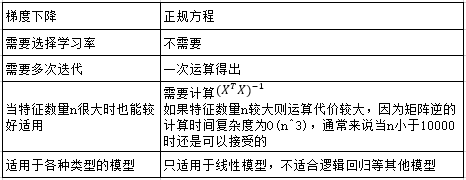1. 线性回归
1.1 线性模型
当输入包含d个特征,预测结果表示为:
![]()
记x为样本的特征向量,w为权重向量,上式可表示为:
![]()
对于含有n个样本的数据集,可用X来表示n个样本的特征集合,其中行代表样本,列代表特征,那么预测值可用矩阵乘法表示为:
![]()
给定训练数据特征X和对应的已知标签y,线性回归的⽬标是找到⼀组权重向量w和偏置b:当给定从X的同分布中取样的新样本特征时,这组权重向量和偏置能够使得新样本预测标签的误差尽可能小。
1.2 损失函数(loss function)
损失函数又称代价函数(cost function),通常用其来度量目标的实际值和预测值之间的误差。在回归问题中,常用的损失函数为平方误差函数:
我们的目标便是求得最小化损失函数下参数w和b的值:
求解上式,一般有以下两种方式:
1> 正规方程(解析解)
![]()
2> 梯度下降(gradient descent)
(1)初始化模型参数的值,如随机初始化;
(2)从数据集中随机抽取小批量样本且在负梯度的方向上更新参数,并不断迭代这一步骤。
上式中:n表示每个小批量中的样本数,也称批量大小(batch size)、α表示学习率(learning rate),n和α的值需要手动预先指定,而不是模型训练得到的,这类参数称为超参数(hyperparameter),选择超参数的过程称为调参(hyperparameter tuning)。
梯度下降和正规方程比较:
1.3 矢量化加速
为了加快模型训练速度,可以采用矢量化计算的方式,这通常会带来数量级的加速。下边用代码简单对比测试下矢量化计算的加速效果。
import math
import time
import numpy as np
import torch
from d2l import torch as d2l
# a、b是全为1的10000维向量
n = 10000
a = torch.ones(n)
b = torch.ones(n)
class Timer:
def __init__(self):
"""记录多次运行时间"""
self.tik = None
self.times = []
self.start()
def start(self):
"""启动计时器"""
self.tik = time.time()
def stop(self):
"""停止计时器并将时间记录在列表中"""
self.times.append(time.time() - self.tik)
return self.times[-1]
def avg(self):
"""返回平均时间"""
return sum(self.times) / len(self.times)
def sum(self):
"""返回总时间"""
return sum(self.times)
def cumsum(self):
"""返回总时间"""
return np.array(self.times).cumsum().tolist()
c = torch.zeros(n)
timer = Timer()
for i in range(n):
c[i] = a[i] + b[i]
print(f'{timer.stop():.5f} sec')
timer.start()
d = a + b
print(f'{timer.stop():.5f} sec')
代码运行结果如下,可见矢量化代码确实极大的提高了计算速度。
注:这里矢量化计算d=a+b的时间不知道为什么统计出来是0,可能是跟电脑的计时器精度有关。
2. 从零实现线性回归
线性回归的实现过程可以简单总结为以下几个步骤:
(1)读取数据(或构造数据),转换成需要的格式和类型,并生成标签 ;
(2)定义初始化模型参数、定义模型、定义损失函数、定义优化算法;
(3)使用优化算法训练模型。
import random
import torch
import numpy as np
from matplotlib import pyplot as plt
from d2l import torch as d2l
# 构造数据集
def synthetic_data(w, b, num_examples):
"""生成 y = Xw + b + 噪声。"""
# 均值为0,方差为1的随机数,行数为样本数,列数是w的长度(行代表样本,列代表特征)
X = torch.normal(0, 1, (num_examples, len(w))) # pytorch较新版本
# X = torch.tensor(np.random.normal(0, 1, (num_examples, len(w))), dtype=torch.float32) # pytorch1.1.0版本
y = torch.matmul(X, w) + b
# 均值为0,方差为1的随机数,噪声项。
y += torch.normal(0, 0.01, y.shape) # pytorch较新版本
# y += torch.tensor(np.random.normal(0, 0.01, y.shape), dtype=torch.float32) # pytorch1.1.0版本
return X, y.reshape((-1, 1))
true_w = torch.tensor([2, -3.4])
true_b = 4.2
features, labels = synthetic_data(true_w, true_b, 1000)
print('features:', features[0], '\nlabel:', labels[0])
d2l.set_figsize()
d2l.plt.scatter(features[:, 1].detach().numpy(), labels.detach().numpy(), 1)
# 生成一个data_iter函数,该函数接收批量大小、特征矩阵和标签向量作为输入,生成大小为batch_size的小批量
def data_iter(batch_size, features, labels):
num_examples = len(features)
indices = list(range(num_examples))
# 这些样本是随机读取的,没有特定的顺序
random.shuffle(indices)
for i in range(0, num_examples, batch_size):
batch_indices = torch.tensor(indices[i:min(i+batch_size, num_examples)])
yield features[batch_indices], labels[batch_indices]
batch_size = 10
for X, y in data_iter(batch_size, features, labels):
print(X, '\n', y)
break
# 定义初始化模型参数
w = torch.normal(0, 0.01, size=(2, 1), requires_grad=True) # pytorch较新版本
# w = torch.autograd.Variable(torch.tensor(np.random.normal(0, 0.01, size=(2, 1)),
# dtype=torch.float32), requires_grad=True) # pytorch1.1.0版本
b = torch.zeros(1, requires_grad=True)
# 定义模型
def linreg(X, w, b):
"""线性回归模型。"""
return torch.matmul(X, w) + b
# 定义损失函数
def squared_loss(y_hat, y):
"""均方损失。"""
return (y_hat - y.reshape(y_hat.shape))**2 / 2
# 定义优化算法
def sgd(params, lr, batch_size):
"""小批量随机梯度下降"""
with torch.no_grad():
for param in params:
param -= lr * param.grad / batch_size
param.grad.zero_()
# 训练过程
lr = 0.03
num_epochs = 3
net = linreg
loss = squared_loss
for epoch in range(num_epochs):
for X, y in data_iter(batch_size, features, labels):
l = loss(net(X, w, b), y) # X和y的小批量损失
# 因为l形状是(batch_size, 1),而不是一个标量。l中的所有元素被加到一起并以此来计算关于[w, b]的梯度
l.sum().backward()
sgd([w, b], lr, batch_size) # 使用参数的梯度更新参数
with torch.no_grad():
train_l = loss(net(features, w, b), labels)
print(f'epoch {epoch + 1}, loss {float(train_l.mean()):f}')
print(f'w的估计误差:{true_w - w.reshape(true_w.shape)}')
print(f'b的估计误差:{true_b - b}')
3. 使用深度学习框架(PyTorch)实现线性回归
使用PyTorch封装的高级API可以快速高效的实现线性回归
import numpy as np
import torch
from torch import nn # 'nn'是神经网路的缩写
from torch.utils import data
from d2l import torch as d2l
# 构造数据集
def synthetic_data(w, b, num_examples):
"""生成 y = Xw + b + 噪声。"""
# 均值为0,方差为1的随机数,行数为样本数,列数是w的长度(行代表样本,列代表特征)
X = torch.normal(0, 1, (num_examples, len(w))) # pytorch较新版本
# X = torch.tensor(np.random.normal(0, 1, (num_examples, len(w))), dtype=torch.float32) # pytorch1.1.0版本
y = torch.matmul(X, w) + b
# 均值为0,方差为1的随机数,噪声项。
y += torch.normal(0, 0.01, y.shape) # pytorch较新版本
# y += torch.tensor(np.random.normal(0, 0.01, y.shape), dtype=torch.float32) # pytorch1.1.0版本
return X, y.reshape((-1, 1))
true_w = torch.tensor([2, -3.4])
true_b = 4.2
features, labels = synthetic_data(true_w, true_b, 1000)
d2l.set_figsize()
d2l.plt.scatter(features[:, 1].detach().numpy(), labels.detach().numpy(), 1)
# 调用框架中现有的API来读取数据
def load_array(data_arrays, batch_size, is_train=True):
"""构造一个PyTorch数据迭代器"""
dataset = data.TensorDataset(*data_arrays)
return data.DataLoader(dataset, batch_size, shuffle=is_train)
batch_size = 10
data_iter = load_array((features, labels), batch_size)
print(next(iter(data_iter)))
# 使用框架预定义好的层
net = nn.Sequential(nn.Linear(2, 1))
# 初始化模型参数(等价于前边手动实现w、b以及network的方式)
net[0].weight.data.normal_(0, 0.01) # 使用正态分布替换掉w的值
net[0].bias.data.fill_(0)
# 计算均方误差使用MSELoss类,也称为平方L2范数
loss = nn.MSELoss()
# 实例化SGD实例
trainer = torch.optim.SGD(net.parameters(), lr=0.03)
# 训练
num_epochs = 3 # 迭代三个周期
for epoch in range(num_epochs):
for X, y in data_iter:
l = loss(net(X), y)
trainer.zero_grad() # 优化器,先将梯度清零
l.backward()
trainer.step() # 模型更新
l = loss(net(features), labels)
print(f'epoch {epoch + 1}, loss {l:f}')
w = net[0].weight.data
print('w的估计误差:', true_w - w.reshape(true_w.shape))
b = net[0].bias.data
print('b的估计误差:', true_b - b)
4. 报错总结
1. torch.normal()报错,这个是由于PyTorch版本问题,torch.normal()函数的参数形式和用法有所变化。
要生成均值为0且方差为1的随机数,pytorch1.1.0和pytorch1.9.0可以分别采用以下形式:
# pytorch1.9.0 X = torch.normal(0, 1, (num_examples, len(w))) # pytorch1.1.0(也适用于高版本) X = torch.tensor(np.random.normal(0, 1, (num_examples, len(w))), dtype=torch.float32)
2. d2l库安装报错。这个我在公司电脑上直接一行pip install d2l成功安装,回家换自己电脑,各种报错。解决之后发现大多都是找不到安装源、缺少相关库或者库版本不兼容的问题。
安装方式:conda install d2l 或 pip install d2l。网速太慢下不下来可以选择国内源镜像:
pip install d2l -i http://pypi.douban.com/simple/ --trusted-host pypi.douban.com
国内常用源镜像:
# 清华:https://pypi.tuna.tsinghua.edu.cn/simple # 阿里云:http://mirrors.aliyun.com/pypi/simple/ # 中国科技大学 https://pypi.mirrors.ustc.edu.cn/simple/ # 华中理工大学:http://pypi.hustunique.com/ # 山东理工大学:http://pypi.sdutlinux.org/ # 豆瓣:http://pypi.douban.com/simple/
需要注意的是:有时候使用conda install d2l命令无法下载,改为pip 命令后即可下载成功。这是因为有些包只能通过pip安装。Anaconda提供超过1,500个软件包,包括最流行的数据科学、机器学习和AI框架,这与PyPI上提供的150,000多个软件包相比,只是一小部分。
Python官方安装whl包和tar.gz包安装方法:
安装whl包:pip install wheel,pip install xxx.whl
安装tar.gz包:cd到解压后路径,python setup.py install
参考资料
[1] Python错误笔记(2)之Pytorch的torch.normal()函数
[2] 动手学深度学习 李沐




